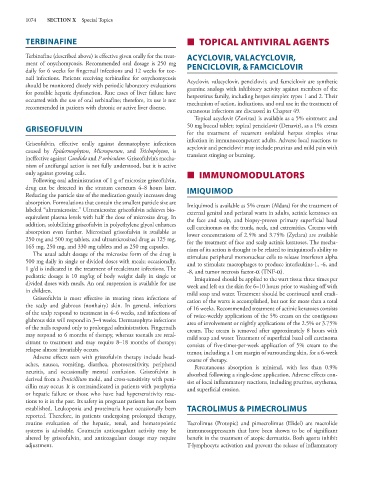Page 1088 - Basic _ Clinical Pharmacology ( PDFDrive )
P. 1088
1074 SECTION X Special Topics
TERBINAFINE ■ TOPICAL ANTIVIRAL AGENTS
Terbinafine (described above) is effective given orally for the treat- ACYCLOVIR, VALACYCLOVIR,
ment of onychomycosis. Recommended oral dosage is 250 mg PENCICLOVIR, & FAMCICLOVIR
daily for 6 weeks for fingernail infections and 12 weeks for toe-
nail infections. Patients receiving terbinafine for onychomycosis Acyclovir, valacyclovir, penciclovir, and famciclovir are synthetic
should be monitored closely with periodic laboratory evaluations guanine analogs with inhibitory activity against members of the
for possible hepatic dysfunction. Rare cases of liver failure have herpesvirus family, including herpes simplex types 1 and 2. Their
occurred with the use of oral terbinafine; therefore, its use is not mechanism of action, indications, and oral use in the treatment of
recommended in patients with chronic or active liver disease.
cutaneous infections are discussed in Chapter 49.
Topical acyclovir (Zovirax) is available as a 5% ointment and
GRISEOFULVIN 50 mg buccal tablet; topical penciclovir (Denavir), as a 1% cream
for the treatment of recurrent orolabial herpes simplex virus
infection in immunocompetent adults. Adverse local reactions to
Griseofulvin, effective orally against dermatophyte infections
caused by Epidermophyton, Microsporum, and Trichophyton, is acyclovir and penciclovir may include pruritus and mild pain with
ineffective against Candida and P orbiculare. Griseofulvin’s mecha- transient stinging or burning.
nism of antifungal action is not fully understood, but it is active
only against growing cells. ■ IMMUNOMODULATORS
Following oral administration of 1 g of microsize griseofulvin,
drug can be detected in the stratum corneum 4–8 hours later. IMIQUIMOD
Reducing the particle size of the medication greatly increases drug
absorption. Formulations that contain the smallest particle size are Imiquimod is available as 5% cream (Aldara) for the treatment of
labeled “ultramicrosize.” Ultramicrosize griseofulvin achieves bio- external genital and perianal warts in adults, actinic keratoses on
equivalent plasma levels with half the dose of microsize drug. In the face and scalp, and biopsy-proven primary superficial basal
addition, solubilizing griseofulvin in polyethylene glycol enhances cell carcinomas on the trunk, neck, and extremities. Creams with
absorption even further. Microsized griseofulvin is available as lower concentrations of 2.5% and 3.75% (Zyclara) are available
250 mg and 500 mg tablets, and ultramicrosized drug as 125 mg, for the treatment of face and scalp actinic keratoses. The mecha-
165 mg, 250 mg, and 330 mg tablets and as 250 mg capsules. nism of its action is thought to be related to imiquimod’s ability to
The usual adult dosage of the microsize form of the drug is stimulate peripheral mononuclear cells to release interferon alpha
500 mg daily in single or divided doses with meals; occasionally, and to stimulate macrophages to produce interleukins-1, -6, and
1 g/d is indicated in the treatment of recalcitrant infections. The -8, and tumor necrosis factor-α (TNF-α).
pediatric dosage is 10 mg/kg of body weight daily in single or Imiquimod should be applied to the wart tissue three times per
divided doses with meals. An oral suspension is available for use week and left on the skin for 6–10 hours prior to washing off with
in children. mild soap and water. Treatment should be continued until eradi-
Griseofulvin is most effective in treating tinea infections of cation of the warts is accomplished, but not for more than a total
the scalp and glabrous (nonhairy) skin. In general, infections of 16 weeks. Recommended treatment of actinic keratoses consists
of the scalp respond to treatment in 4–6 weeks, and infections of of twice-weekly applications of the 5% cream on the contiguous
glabrous skin will respond in 3–4 weeks. Dermatophyte infections area of involvement or nightly applications of the 2.5% or 3.75%
of the nails respond only to prolonged administration. Fingernails cream. The cream is removed after approximately 8 hours with
may respond to 6 months of therapy, whereas toenails are recal- mild soap and water. Treatment of superficial basal cell carcinoma
citrant to treatment and may require 8–18 months of therapy; consists of five-times-per-week application of 5% cream to the
relapse almost invariably occurs. tumor, including a 1 cm margin of surrounding skin, for a 6-week
Adverse effects seen with griseofulvin therapy include head- course of therapy.
aches, nausea, vomiting, diarrhea, photosensitivity, peripheral Percutaneous absorption is minimal, with less than 0.9%
neuritis, and occasionally mental confusion. Griseofulvin is absorbed following a single-dose application. Adverse effects con-
derived from a Penicillium mold, and cross-sensitivity with peni- sist of local inflammatory reactions, including pruritus, erythema,
cillin may occur. It is contraindicated in patients with porphyria and superficial erosion.
or hepatic failure or those who have had hypersensitivity reac-
tions to it in the past. Its safety in pregnant patients has not been
established. Leukopenia and proteinuria have occasionally been TACROLIMUS & PIMECROLIMUS
reported. Therefore, in patients undergoing prolonged therapy,
routine evaluation of the hepatic, renal, and hematopoietic Tacrolimus (Protopic) and pimecrolimus (Elidel) are macrolide
systems is advisable. Coumarin anticoagulant activity may be immunosuppressants that have been shown to be of significant
altered by griseofulvin, and anticoagulant dosage may require benefit in the treatment of atopic dermatitis. Both agents inhibit
adjustment. T-lymphocyte activation and prevent the release of inflammatory

